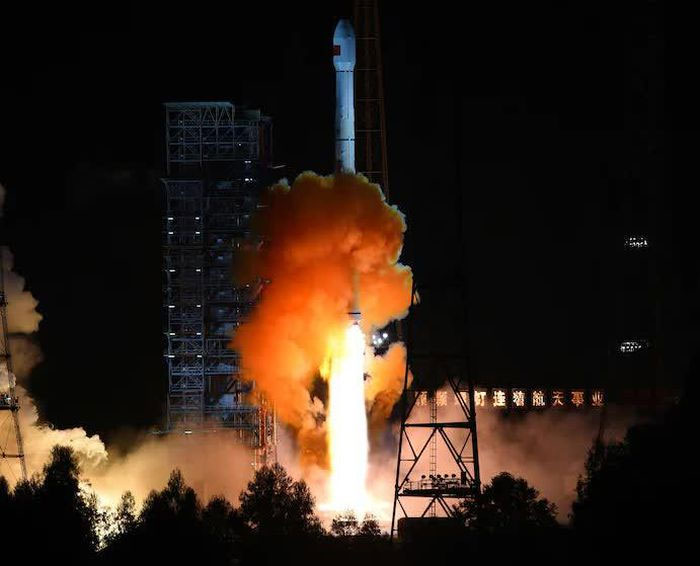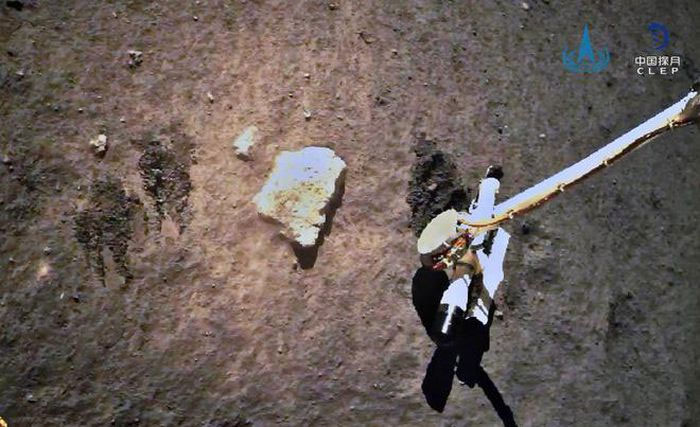NASA will monitor this event.
Upcoming Collision Between a Rocket and the Moon
A leftover piece of a Chinese rocket launched into space in 2014 is set to crash into the Moon on March 4, 2022, at a speed of about 9,000 km/h (equivalent to 2,500 meters/second). This “unintentional” collision of humanity’s first artificial object with the Moon will create a 20-meter-wide impact crater on the surface of Earth’s natural satellite, Forbes reports.
Interestingly, a part of China’s Long March 3C/E rocket (this part is designated 2014-065B, the booster of the Long March 3C/E) originated from a Chinese mission to return a Moon rock sample to help scientists understand why the Moon is so heavily frozen.
* The Long March 3C/E rocket is an upgraded version of the Long March 3C.

An unmanned spacecraft launched atop the Long March 3C/E rocket from the Xichang Satellite Launch Center in Sichuan Province, China, in October 2014. (Photo: Jiang Hongjing / Xinhua / AP)
Previously, in October 2024, at the Xichang Satellite Launch Center, China launched the Long March 3C/E rocket for the Chang’e 5-T1 mission. This was a precursor mission [to test a capsule during re-entry into Earth’s atmosphere] before the country undertook the full Chang’e-5 mission.
Currently, according to astronomers’ observations, 2014-065B – weighing about 4 tons – is moving quite rapidly in a high elliptical orbit around Earth. By early March 2022, 2014-065B will be hurtling towards the Moon at a speed of 9,000 km/h, ultimately colliding with the surface of this natural satellite.
China and SpaceX Remain Silent
Earlier, American planetary scientist Bill Gray was the first to report that a piece of an old Falcon 9 rocket from SpaceX would crash into the Moon. However, after further examination, Bill Gray “corrected” himself, stating that it was the booster of the Long March 3C/E rocket manufactured and launched by China eight years ago.
As for the old Falcon 9 rocket from SpaceX, it is currently unclear where the second stage of the Falcon 9 is in deep space.
Officials from both SpaceX and China’s Lunar Exploration Program have not provided any comments or responses after receiving this information.
The Near-Earth Object Research Center at NASA’s Jet Propulsion Laboratory also indicated that the object expected to impact the far side of the Moon on March 4 is part of the Long March 3C/E rocket, Washington Post reports.
NASA and India have stated that they will monitor this event on March 4, 2022, using NASA’s Lunar Reconnaissance Orbiter (LRO) and India’s Chandrayaan-2 – both of which are in orbit around the Moon.

This image, taken by the China National Space Administration (CNSA) on December 2, 2020, and released on December 3, 2020, shows the Chang’e-5 lunar probe collecting samples on the Moon. This marks the first Moon sample return in the world in 40 years. (Photo: China National Space Administration (CNSA) via CNS / AFP).
For China, thanks to the Chang’e 5-T1 mission, the sample return mission Chang’e-5 was more successful than expected. At the end of December 2020, Chang’e-5 successfully brought Moon samples back to Earth for China, making it the third country, after the United States and the Soviet Union, to accomplish this challenging mission. This was also the first Moon sample return mission in 46 years since the last Soviet mission in 1976.
The Moon rocks brought back by Chang’e-5 are about 2 billion years old, making them the youngest Moon rocks available to scientists. These samples indicate that the Moon has been geologically active for much longer than previously thought.
Power of the Long March 3C Rocket
To date, the Long March rocket family is the backbone of China’s space exploration programs. It is also the country’s most powerful rocket.
Variants of the Long March have been, are, and will conduct space missions such as launching satellites into orbit, sending probes/explorers to the Moon, Mars, asteroids, and more.
The China Aerospace Science and Technology Corporation (CASC) is the primary contractor for China’s space program.
- The Long March 3C is an orbital launch vehicle from China, with the Long March 3C/E being an upgraded version of the Long March 3C. It is designed to fill the payload capacity gap between the Long March 3A and 3B.
- CASC allocated $20 million for the China Academy of Launch Vehicle Technology (CALT) to produce the Long March 3C rocket.
- The Long March 3C has a total height of 55.64 meters.
- The Long March 3C can deliver a payload of 8 tons to Low Earth Orbit (LEO) and 3.9 tons to Geostationary Transfer Orbit (GTO).
- This is a three-stage rocket with two strap-on boosters powered by liquid fuel. The power of the Long March 3C is demonstrated through its booster and three stages:
The booster is supported by two strap-on boosters, each 16.1 meters long and powered by YF-25 engines. The engines run on dinitrogen tetroxide (N2O4) and unsymmetrical dimethylhydrazine (UDMH), with each engine producing 740.4 kN of thrust. The boosters burn for 140 seconds.
The first stage has four Y4-21C engines, similar to the YF-25 engines on the boosters, powered by N2O4 and UDMH. The first stage burns for 158 seconds and produces 2,960 kN of thrust. It has a length of 24.7 meters and a diameter of 3.35 meters.
The second stage features a YF-24E engine module. The module contains one main YF-24E engine for thrust and four YF-23C engines. The main engine produces 742 kN of thrust while each YF-23C engine produces 47.1 kN. Like the booster and first-stage engines, they run on N2O4 and UDMH. This stage has a length of 12.9 meters, a diameter of 3.3 meters, and burns for 185 seconds.
The third stage of the rocket has a YF-75 engine running on liquid hydrogen (LH2) and liquid oxygen (LOx), producing 167 kN of thrust. This section has a length of 12.3 meters and a diameter of 3 meters, burning for 487 seconds.


















































